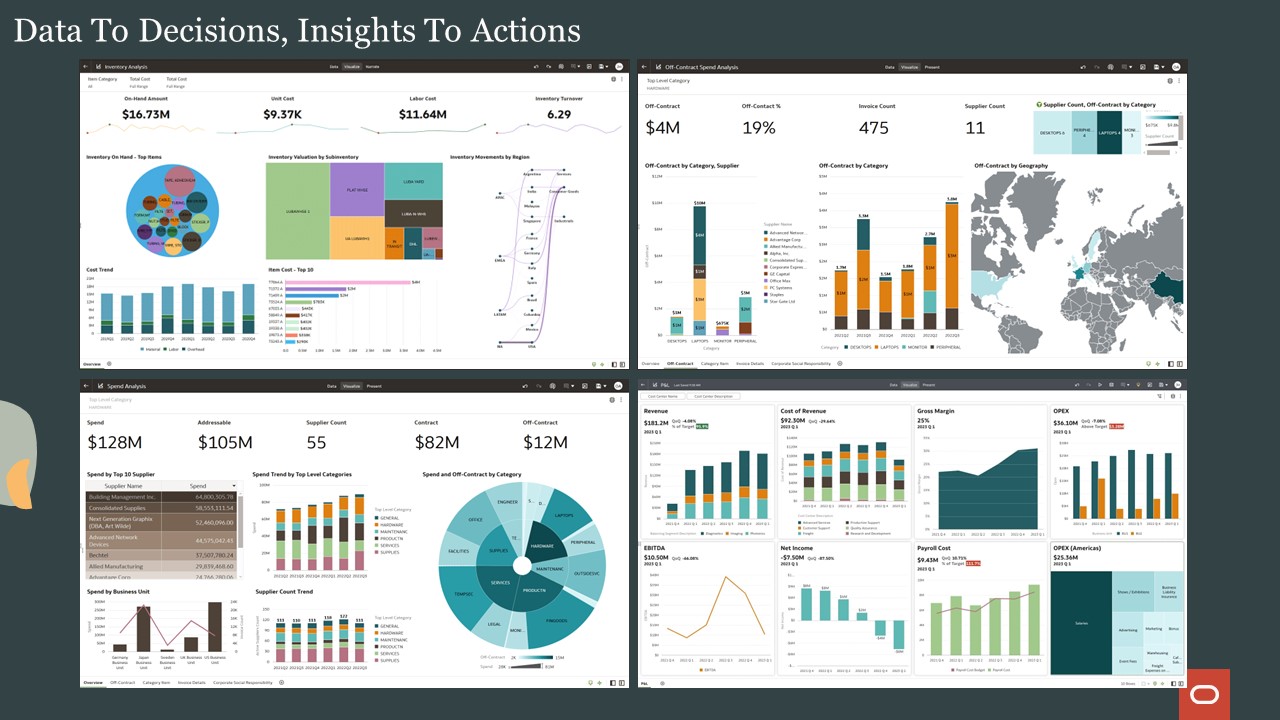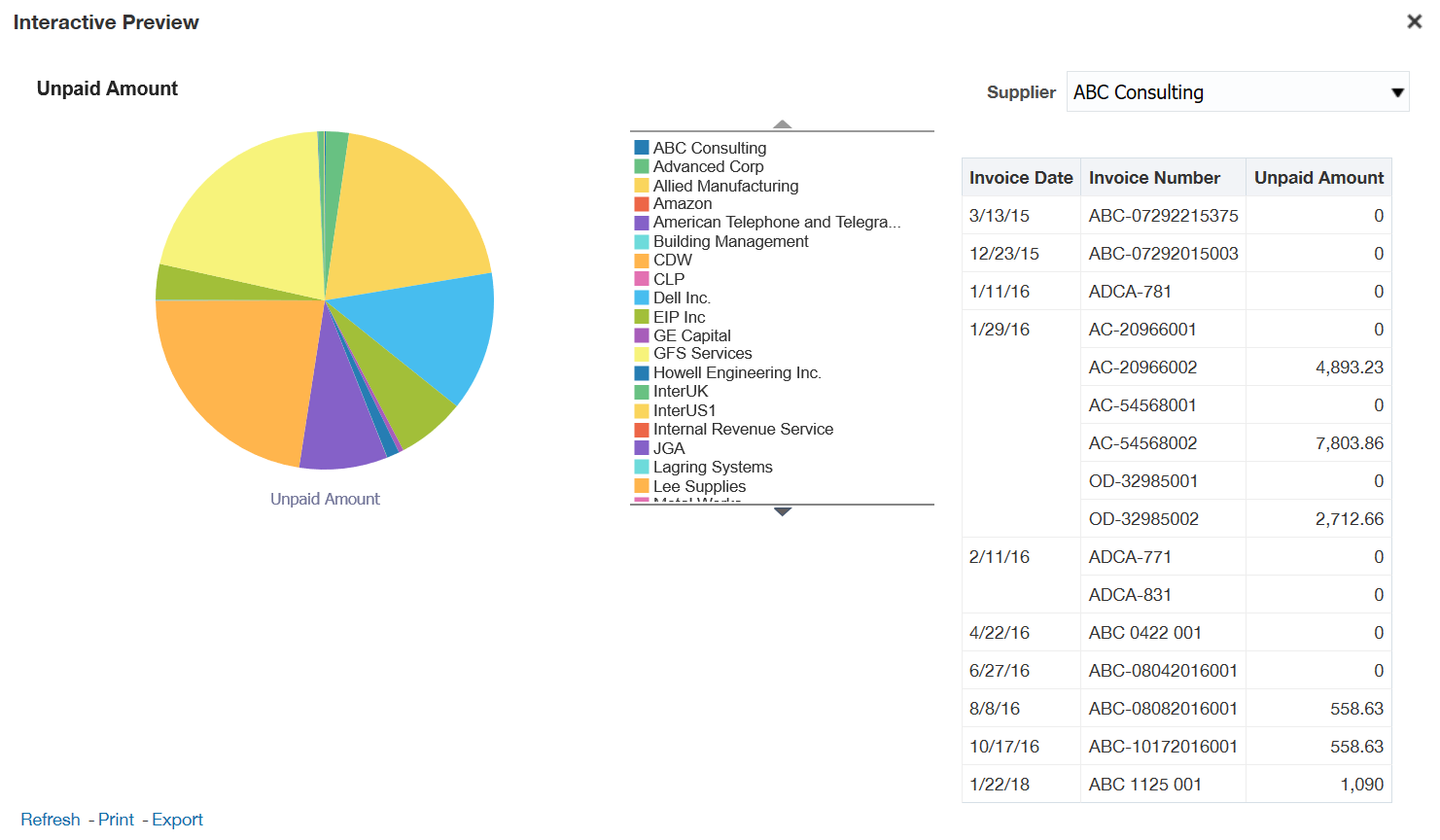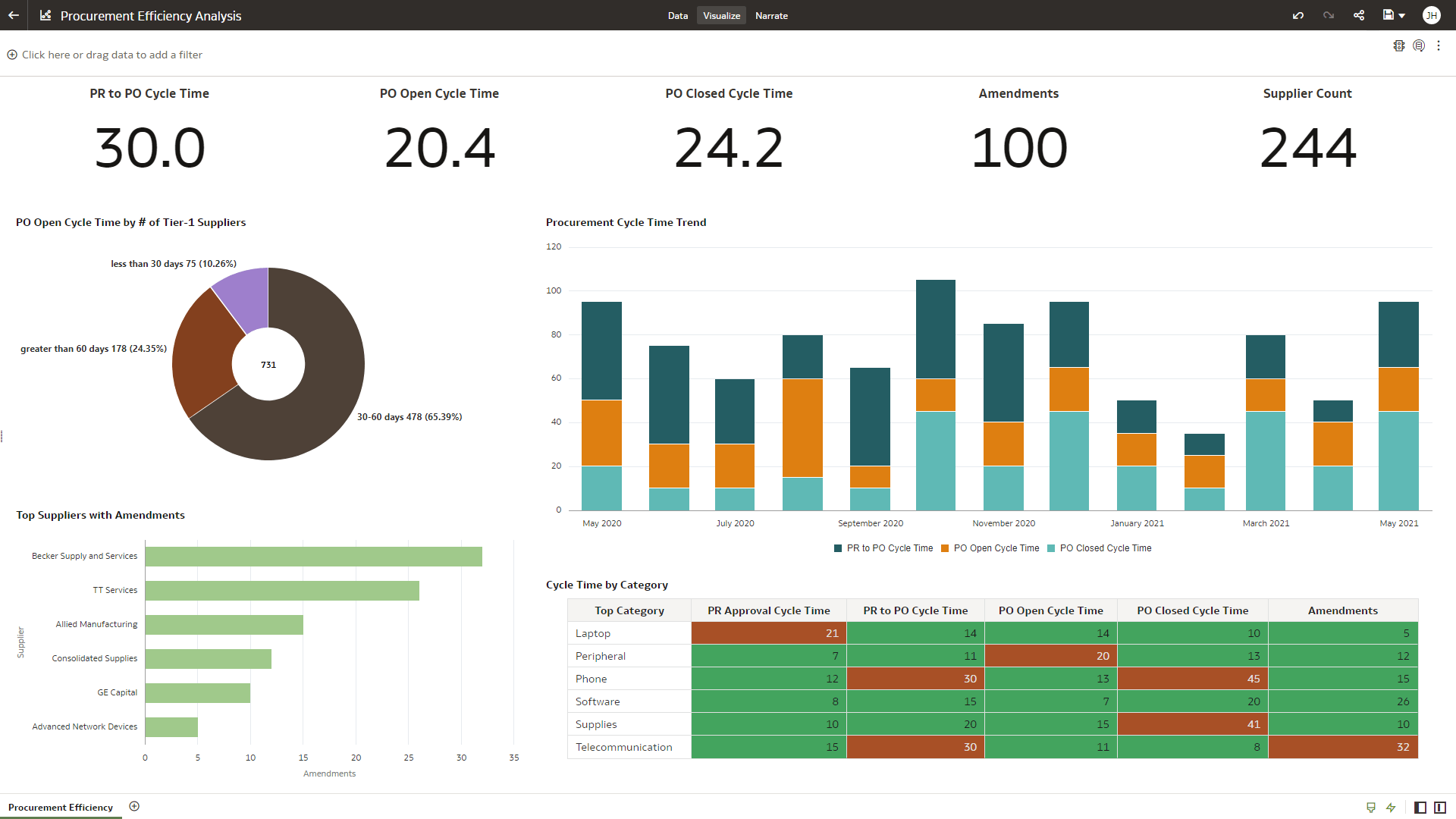When it comes to analytics, businesses need more than just data. They need AI-powered, actionable intelligence that drives business decisions. They also need actionable insights that shape fast, accurate, and strategic directives for everyone involved. By leveraging the power of Oracle Cloud Applications along with Oracle’s powerful analytics capabilities, businesses can do just that. They can enable the power of information to drive business success and produce actionable intelligence when and where it is needed most.
Within any business, various people will have various information needs for various goals. A Chief Financial Officer (CFO) wants global snapshots of business health such as total revenue, current cash reserves, and overall profitability. But an Accounts Receivable (AR) Manager will want metrics such as the largest account balances, customers with persistently late payments, and overall days sales outstanding (DSO). With every critical metric, it’s now more important than ever that companies get the information they need to turn data into decisions and insights into actions.

Fortunately, for Oracle Cloud Applications customers, the applications come with a variety of prebuilt and included out-of-the-box analytics functionality to reduce costs, increase efficiency, and drive success. Embedded analytics run against real-time, up-to-the-minute production data, so there is never a delay in obtaining the most-timely information. An overview of embedded Oracle Cloud Application analytics functionality includes, but is not limited to the following:
Key Performance Indicators (KPIs): KPIs serve as a starting point for business metrics. Oracle delivers many in prebuilt form, but customers can also create their own. KPIs are arranged in dashboard style to offer quick, high-level data visualization, and they come preconfigured based on user roles. By promoting a glance, scan, and commit strategy, KPIs provide users, teams, and leaders with essential information from various sources to help swiftly identify business areas requiring attention. Plus, KPIs are easy to work with and can easily be shared within an organization.

Analytics and reports: Out-of-the-box, Oracle Cloud Applications include the ability to create a variety of analytics and reports that generate timely, actionable intelligence for different business areas. Customers can build on Oracle pre-built reports or create new reports in a variety of formats using simple, wizard-driven functionality. Business and data insights can then facilitate understanding of critical data patterns. Users can be notified of key events and data anomalies. Embedded reporting can be used to create both simple and complex reports, while alerts, agents, and dashboards can be embedded directly into Oracle Cloud Application pages. Furthermore, deep links on dashboards allow for direct access to underlying transactions. And pre-built subject-area views of data simplify the report generation process. If necessary, customers can also perform ad-hoc style querying to create data models based on underlying tables in the database.

External-facing reports: Oracle Cloud Applications also include the ability to produce external-facing reports and documents that are needed by most organizations. This includes items such as checks, invoices, purchase orders, and financial statements. A notable aspect of this functionality is the separation of report layout from data extraction. Users can design and create report layout templates using common desktop applications such as Microsoft Word and Adobe Acrobat. The applications then generate reports in various formats (PDF, RTF, Excel, HTML, etc.) and in multiple spoken languages. This approach reduces report maintenance and empowers business users to make report adjustments without relying on technical teams for assistance.

Extending Embedded Application Reporting
While the out-of-the-box analytics in Oracle Cloud Applications are extremely powerful, customers may also sometimes want to augment and extend that functionality. A primary use case for this is when customers want to standardize on a single enterprise reporting tool for both Oracle Cloud Applications and external data. External data may be from files, spreadsheets, data lakes, applications, data warehouses, or other sources both in a cloud or on-premise. Users may need to interactively analyze, explore, and mashup data across multiple sources or run their own machine learning models against data to produce business guiding predictive outcomes on a single platform.
When these types of reporting requirements exist, customers can choose to leverage Oracle Fusion Data Intelligence (formerly Oracle Fusion Analytics) along-side of their Oracle Cloud Applications. Fusion Data Intelligence provides customers with the ability to analyze data from multiple sources using 360-degree data models and prescriptive AI/ML models that customers can tailor and extend as needed. Customers can easily leverage prebuilt, advanced components such as forecasts, clusters, trend lines, outliers, text analytics, graph analytics, and affinity analyses. Furthermore, Fusion Data Intelligence provides additional prebuilt content specifically for Oracle Cloud Applications. Prebuilt content addresses key business areas such as predicting ERP financials risk, optimizing HCM recruitment, improving CX forecast accuracy, and ensuring on-time SCM deliveries. Fusion Data Intelligence users can now undertake both strategic, predictive analyses to guide the business as well as tactical analyses for streamlining day-to- day operations by accessing Oracle Transactional Business Intelligence (OTBI) subject areas and the latest data visualization capabilities from Oracle Analytics Cloud.
Fusion Data Intelligence empowers users not only through analysis, preparation, visualization, and natural language processing, but also with recommendations to facilitate quicker actions. With every release, more and more AI and machine learning is being built into the platform including generative AI data interactions, machine learning contextual insights, and AI-powered document understanding.

And when it comes to importing data into the platform from external sources, administrators can easily augment data using included data connectors. Both Oracle and non-Oracle Extraction, Transformation, and Loading (ETL) tools can populate the underlying database. And a third option is to give any user the proper privileges to upload data via files or live external connections. Interactively, or on a scheduled basis, users query external sources to produce data sets. Once data is loaded, the platform can generate AI-powered analyses in addition to what is generated out-of-the-box by Oracle Cloud Applications.

On top of a strong data foundation, Oracle Fusion Data Intelligence provides an extremely powerful set of capabilities to instantly visualize data and create compelling insights. It does this by addressing everything from ingestion to modeling, to preparation, to enrichment, and to visualization. Plus, AI-driven Natural Language Processing (NLP) supports both text and speech for conversational search and analysis. Combined with AI-driven recommendations, this empowers users with the ability to have a “conversation” with the data, explore outliers, and use features within the application to highlight where action is required.
All of this creates “actionable intelligence” through unseen signals using embedded AI and predictive analytics. Automated machine learning makes predictions, finds outliers, calculates possibilities, generates trend lines, and uncovers unique insights. Plus, Fusion Data Intelligence customers will have access to the Oracle Analytics Mobile App to view data on the go. As a result, users are no longer tied to their desktops and can instantly obtain the health of their business from mobile devices whenever and wherever their daily activities take them.

Finally, Fusion Data Intelligence customers can also take advantage of the unique podcast feature which leverages embedded AI-driven natural language generation. To generate a podcast, simply tap on the workbook’s context menu and select “listen to podcast” to hear about the trends, shifts, highlights, and anomalies identified in data. After all, who wouldn’t want to hear an audio summary of current business performance while preparing for the day, getting in a workout, or commuting into the office!
Conclusion
To summarize, Oracle Cloud Applications include extremely powerful, out-of-the-box analytics tools that allow users to analyze real-time data within their applications. These tools easily allow operational users to view the data that they need to turn data into decisions and insights into actions.
Customers can augment Oracle Cloud Applications embedded analytics functionality using Oracle Fusion Data Intelligence. While embedded applications functionality allows customers to report extensively on live production transactions, the add-on intelligence platform provides customers with a reporting tool that can be used across the enterprise combining data from nearly any data source. The platform includes additional, pre-built content such as reports, analytics, and dashboards for Oracle Cloud Applications. Therefore, when Oracle Cloud Applications built-in analytics tools are augmented using Oracle Fusion Data Intelligence, there is virtually no application or extended enterprise reporting requirement that cannot be met.
To learn more about how you can improve your business using the powerful reporting options for Oracle Cloud Applications, please reach out to us anytime through your Oracle Applications Sales Team. And for more information on why technology matters for Oracle Cloud Applications, be sure to check out other topics in this blog series, starting with the Introduction.
For further information on Oracle Cloud Applications and Oracle Fusion Data Intelligence, please have a look at the following:
Oracle Fusion Data Intelligence
“This blog series was written by Oracle’s North American Applications, Advanced Technology Team, which is dedicated to helping customers modernize their businesses through technical innovation. They provide subject matter expertise and vision on SaaS, platform technology, operations, and data management.”


